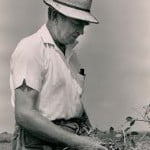 I am speaking this weekend at the Clarence Jordan Symposium at Georgia Southwestern University. It is a celebration and reflection of the life and words of Clarence Jordan who would have turned 100 years old this year. To commemorate this event, and the man who has been more of an influence on me than any other single theologian, I am posting a three part blog on Clarence Jordan. Enjoy, and I hope you come to love this man as I have. – RM
I am speaking this weekend at the Clarence Jordan Symposium at Georgia Southwestern University. It is a celebration and reflection of the life and words of Clarence Jordan who would have turned 100 years old this year. To commemorate this event, and the man who has been more of an influence on me than any other single theologian, I am posting a three part blog on Clarence Jordan. Enjoy, and I hope you come to love this man as I have. – RM
# # # # #
For all his accomplishments, Clarence Jordan’s lasting legacy will be two-fold. First, there is the Cotton Patch gospel. It is his best known work, printed after his death. The Cotton Patch gospel is a translation of the Greek New Testament into the vernacular and times of South Georgia in the 1960s. It was not intended for scholars and seminary students, but as a work of contextualization – for those poor black and white sharecroppers who could not read the King’s English.
In the Cotton Patch gospel, Jesus is not born in Bethlehem, but in Gainesville, Georgia. There was no room at the hospital, so they laid him not in a manger, but in an apple box. The Scribes and the Pharisees of the New Testament are transformed into the good, white, church people of the South, and the sinners and tax collectors are the black sons and daughters of slaves, and poor white-trash, redneck share croppers. Jesus isn’t crucified in Jerusalem – he’s lynched – by the leaders of the Southern Baptist Convention.
Not only did Jordan write in such a way that the people to whom he ministered would understand the words of the gospel, he lived in such a way that they saw it and could imitate it. What a challenge for the church! Can we speak and live and love in such a way that people experience the gospel? I we begin to grasp what Clarence Jordan taught, that the “proof that God raised Jesus from the dead is not an empty tomb, but the full hearts of his transformed disciples,” then we just might begin to live our lives built on the works and words of Jesus.
And second will be the legacy of partnership housing: In July 1968, a man named Millard Fuller moved to Koinonia Farms with his wife Linda and their children. Millard had been a multi-millionaire but struggling to follow the words of Jesus himself, had given away his entire fortune. He and Clarence birthed this idea that poor people, God’s people, could be provided decent, affordable housing if the church would live out a few simple, radical ideas. Millard and Clarence began building houses with their partners. A simple, decent house would be built by volunteers and sold to families who financially qualified, and the family would pay no interest – only the cost of building the house. As the house payments were made, those payments went into a Fund for Humanity that precipitated the building of even more houses.
The first such partnership homes were built in the early 1970s at Koinonia. And in 1976, Millard and Linda Fuller took the idea nationally. They started a small Americus-based organization you may have heard of: Habitat for Humanity. They went on to found, years later, the Fuller Center for Housing. These organizations have built hundreds of thousands of homes and will shelter millions in the years to come.
Millard Fuller became my friend, before his death, and his family remains endeared to me. Every time I see one of them, shake their hand or hug their neck, I realize I’m one handshake removed from Clarence Jordan himself. And every person who has ever volunteered on a Habitat or Fuller Center work project or has given money to sponsor a home, in effect is taking hands with Clarence and continuing his work.
Clarence did not live to see even the first Partnership house. In October 1969, a year before I was even born, sitting in his writing shack translating his Cotton Patch version of the New Testament, Clarence died of a heart attack. The community still reviled him to such a degree, that the coroner and county medical examiner refused to come to the Farm to pronounce his death. The county instructed Millard Fuller, who was with Clarence at his death, that the best he could do was to rent an ambulance and bring the body to the hospital. Millard thought about it and concluded that Clarence wouldn’t want that kind of money spent for him in death. So, Millard loaded Clarence into the car and drove him to town, smiling all the way, because he knew Clarence would have gotten a real charge out of the whole scene.
Clarence was buried at Picnic Hill in an unmarked grave at Koinonia Farms, his coffin a pine box crate. He lived and died according to his own definition of faith – “a life lived in scorn of the consequences.”
These posts may best be concluded with Clarence’s Cotton Patch version of the Lord’s Prayer:
Father, may your name be taken seriously.
May your Movement spread.
Sustaining bread, grant us each day.
And free us from our sins, even as we release everyone indebted to us.
And don’t let us get all tangled up. Amen.
To learn more about Clarence and Koinonia Farms, see Briars in the Cotton Patch, directed by my friend Faith Fuller

